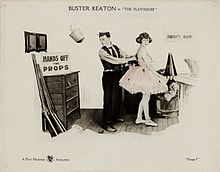The Playhouse (film)
| The Playhouse | |
|---|---|

Lobby card for the film
|
|
| Directed by |
Buster Keaton Edward F. Cline |
| Produced by | Joseph M. Schenck |
| Written by |
Edward F. Cline Buster Keaton |
| Starring |
Buster Keaton Virginia Fox Joe Roberts Edward F. Cline (uncredited) |
| Cinematography | Elgin Lessley |
| Distributed by | First National Pictures Inc. |
|
Release date
|
|
|
Running time
|
22 min. |
| Country | United States |
| Language | Silent (English intertitles) |
The Playhouse is a 1921 American silent short comedy film written, directed by, and starring Buster Keaton. The movie runs for 22 minutes, and is most famous for an opening sequence in which Keaton plays every role.
The film is set up as a series of humorous tricks on the audience, with constant doubling, and in which things are rarely what they at first seem to be. It opens with Keaton attending a variety show. In this first sequence, Keaton plays beside him and remarks, "This fellow Keaton seems to be the whole show." This was a gibe at one of Keaton's contemporaries, Thomas Ince, who credited himself generously in his film productions. In interviews with Kevin Brownlow, Keaton claims he gave the director's credit to Cline mainly because he did not want to appear too Ince-like himself: "Having kidded things like that, I hesitated to put my own name on as a director and writer."
This elaborate trick-photography sequence turns out to be only a dream when Joe Roberts rouses Keaton from bed. The bedroom then turns out to be not a bedroom, but a set on a stage.
The second half of the film features Keaton's character falling for a girl who happens to be a twin. He has difficulty telling the twin who likes him from the one who does not. An uncredited Virginia Fox plays one of the twins. Edward F. Cline co-wrote the production and appears, uncredited, as a monkey trainer, whose monkey Keaton impersonates onstage after accidentally letting the animal escape.
Keaton's portrayal of nine members of a minstrel show required the use of a special matte box in front of the camera lens. It had nine exactingly-machined strips of metal which could be moved up and down independently of each other. Elgin Lessley, Keaton's cameraman, shot the far-left Keaton with the first shutter up, and the others down. He then rewound the film, opened the second segment, and re-filmed the next Keaton in sequence. This procedure was repeated seven more times. The camera was hand-wound, so Lessley's hand had to be absolutely steady to avoid any variation in speed. Keaton relied on a metronome to guide him, not a problem in a silent film. It was decades before Keaton, who masterminded this, revealed his technique to other filmmakers.
...
Wikipedia
